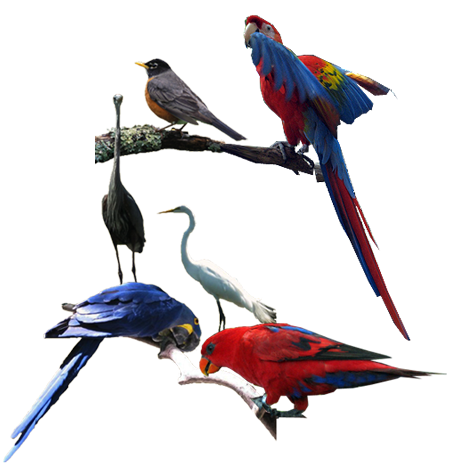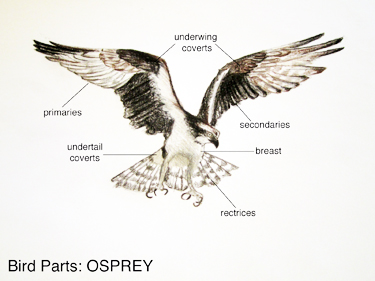
Birds are a big part of our lives, our history, and our ecosystem. They are free to soar in the skies, sit on your rooftop, and walk in your yard. However, many of us hardly notice birds in our daily life (except for the unfortunate droppings from above) and take for granted just how important they are!
There are over 10,000 bird species in the world and they all have their own stories. While 925 species have been sited in the U.S and Canada, South America has the largest concentration of birds with over 3,200 bird species. The study of birds is known as ornithology and scientists who study birds are called ornithologists. Birds attract mates, build nests, protect their territory, and hunt for food. Birds play a large place in the ecology, as they are an important part of the food web.
Early civilizations such as the Egyptians drew birds as spirits and gods on tombs. Romans used the pattern of birds to determine the will of gods. Birds traveled between continents for thousands of years before explorers found them. Between seasons, birds migrate to different continents to find food and a better place to breed. In order to make this move easy, they usually travel in a V formation to decrease air resistance and make it easier for the flock to stick together.
Be a Bird Watcher!
Activity 1 – Be a Birdwatcher

Look out a window. Walk to school and search the treetops. Walk along the river or in a park and listen for bird sounds. For one week, record with photos, sketches and notes how many birds you see. What can you learn from looking for birds? Seeing a bird will give us information about its size, coloring, markings, flying ability, social life, nesting and habitation patterns. Bird watchers observe the size and shape, color pattern, behavior, range, habitat, field marks, flight, songs and calls.
Be a Bird Watcher!
Activity 2 – Bird Guides

Go to the library and check out a bird guide or the download (English and/or Spanish) Cornell Lab of Ornithology, an excellent resource to support your birding. It will help you look at size and shape, color and behavior, and habitat, as well as find out what species of birds live in your city. Now grab a guide and your binoculars and go to a park! Use SOUND ID to capture the birds talking, singing, and calling out to each other. Take a walk around and find five different species by using your guide. Take photos, make sketches in your journal.
Let the birds guide you!
Activity 3 – Listen to Birds
Birds chirp, caw, coo, crow, sing, hum, hoot, trill, scream, squawk, and speak many languages. Now grab your guide and your binoculars, and go to a park! Start listening. During different seasons birds call each other to mate, protect their nest, defend their eggs and babies, to plan their migration. Use the SOUND ID app or Cornell Bird Bird ID to record birds talking, singing, and calling out to each other. Then, take a walk around and find three birds using your guide. Take photos, do sketches in your journal, and label each species. Upload your bird drawings or pictures to the gallery.
Activity 4 – Amazing Birds!

Birds are fascinating! They come in many shapes and sizes. They have diverse beak and head shapes, feathers, wing spreads, nails, and webbed feet. Different species speak different languages. This gives them a lot of fun facts to learn about them, too! Did you know that you need to cook an ostrich egg for two hours to get a hard-boiled egg or that a bird’s heart beats much faster than our heart? Birds have a robust circulatory system to fly long distances. A hummingbird’s heart beats about 1,000 times a minute, whereas a human’s beats about 60-90 times! Impress your friends with ten or more interesting facts that you find about birds.
Birds are a fascinating type of animal with lots of interesting adaptations and quirks. This gives them a lot of fun facts to learn about them, too! Birds swarm in the sky in unique patterns called murmurations. They also often fly in a V formation to reduce air resistance and make it easier for the flock to stick together. Birds of a feather flock together!! Make a list of amazing bird facts!
Upload Amazing bird facts to the Gallery!
Activity 5 – Bird Feathers

Bird watchers look at the plumage, or feathers, of birds, to help identify what type of bird it is. They also look at the size, color, call, nesting habits, etc.
Using the Audubon’s Guide to the Parts of a Bird, make a pencil sketch of a bird of your choice. Color the bird and label the five different plumage areas, markings of the head, and bill (beak) parts.
Birds have five different feather types –
remiges: fight feathers
retrices: tail feathers
coverts: covering feathers of the remiges and retrices
upperpart: on the mantle, scapular and surface of the wing
underparts: feathers on the throat, breast, belly, flanks, vent and under tail
Using neat printing, label the five different plumage areas, markings of the head and bill (beak) parts.
Look at the beautiful Bird paintings of Audobon. Birds of a feather flock together! Be a Bird Artist!Birds of a feather flock together!
Be a Bird Artist!
Activity 6 – Feather Art
It is very easy to find and collect beautiful feathers once you start looking for them. Start your very own feather collection for fun. See if you can find different types and colors. Once you have collected at least ten feathers, use your guidebook to try and identify what bird it came from. Make an art piece or a piece of jewelry using your found feathers. Share your work with your friends! Upload your work to the gallery.
Let the birds guide you!
Activity 7 – Birds in the Food Chain

In this activity, draw a food chain that includes a bird. See how important it is that birds have healthy worms, seeds, and grasses to eat. Label the participants in your food chain. What do you think happens if the worms or insects are not available for birds to eat? What do you think happens if the worms and insects in the grass are poisoned by pesticides and weed killers? There is a good chance that the birds will disappear. If there are fewer birds, there will be trouble in the food chain. Insects and birds are key to a healthy food chain. Think about what you can do to help birds. Healthy bird feeders are one good idea. Ask neighbors not to use pesticides and herbicides on their lawns. Be a Bird watcher and protect birds!
Activity 8 – Bird Migration
Seasonally millions of birds migrate to warmer weather and where more food can be found. Between seasons, birds migrate seasonally to different continents to find food, warmer weather, and places to breed. Watch different bird species migrate north in this interactive map by Cornell University! Now that you can see the migrations take a look at which species are where. Some birds that migrate south during the western hemisphere’s winter fly out over the ocean in a clockwise loop and then come north inland to take advantage of air currents. Many species fly the same paths year after year. Choose a species of bird and plot its annual migratory path. Check out amazing data of breeding areas, population location, habitats, and migration paths at Cornell’s e-Bird Status and Trends!! Learn about the miracle of North American Migrations, and research and draw a migration map noting species winter and summer nesting regions.
Review
- How many bird species are found in the U.S and Canada?
- What do birds need to fly?
- What do birds eat?
- How many feather types do bird watchers look for?
- What is the study of birds?
Explore
- 10,000 Birds
- American Museum of Natural History Family of Birds
- APP Audubon Birds ($9.99)
- APP Bird Calls (free)
- APP Birds of North America D. Sibley ($19.99)
- APP Chirp! ($3.99)
- APP Ibird Pro ($9.99)
- App Merlin CornellLab of Ornithology
- Are Birds Really Dinosauers?
- Audobon Aviary
- Audobon Bird Migration
- Audobon Birds of America
- Basics of Bird Migration Cornell Lab
- Bird Families Audubon
- Bird Finder Ask a Biologist
- Bird Game All About Birds (slow load)
- Bird Games
- Bird Guide Audubon Online
- Bird Heroes; Spectogram Fun Identifying Bird Calls
- Bird Images David Attenborough
- Bird Migration
- Bird Migration Basics
- Bird Migration Tired Travelers NASA Radar
- Birds & Biodiversity
- Birds & Climate Visualizer
- Birds Ecology of Loss
- Birds Interesting Facts
- Bird Sleuth
- Birds National Geographic (free)
- Birds of North America Audubon
- Birdsong
- Birdsong and Climate
- BIRDS SONG Poster
- Bird Watching
- ClipBirds Beak Variations & Evolution
- Cornell Bird Species Interactive Map
- Cornell ebird.org
- Cornell Lab Bird Sleuth Investigating Evidence
- Cornell Lab of Ornithology
- Distinguishing Bird Calls
- Early-Bird Interactive Bird Posters
- e-Bird Status & Trends
- EU Nature Laws
- Evolution & Birds
- Half-Earth Maps
- Hummingbird Migration
- Journey North Migration
- Macaulay Library Online Catalogue
- Martin Haake Illustrations (some birds)
- Maya Lin's What is missing?
- Migration Maps Annenberg Media
- Migratory Bird Program
- Migratory Bird Tracking
- Nature Journaling BIRDS
- North American Bird Migration Flyways
- PBS Birds
- Species in Pieces
- State of the Birds Farm Reports
- TEDed Bird Migration-A Perilous Journey
- Video BBC From Egg to Baby Penguin
- Video Come Fly With Me
- Video Explore the World of Birds Video
- Video Genius of Birds – Embryo to High Flier
- Video Hermit Thrush Singing
- Video Kenn Kaufman, Audubon Field Editor
- Video MPM Red Wing Blackbird
- Video Murmurations
- Video Murmurations
- Video Peacock Bird Headress Project K-2
- Videos Birds National Geographic
- Videos Birds National Geographic
- Video The Birds Audubon missed: Kenn Kaufman
- What's Missing
- WI Important Bird Areas



















































